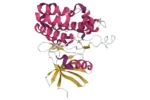Vialox peptide has been suggested to interfere with nerve and muscle signal transmission. Signals are transmitted in normal conditions after nerves release acetylcholine from their axons. Contraction may occur after acetylcholine transportation through the neuromuscular junction and binds to a receptor on the muscle.
Vialox peptide may halt contraction by binding to the AChR.[2] Acetylcholine is prevented from binding due to this action, which may induce less binding and fewer muscle contractions.
At the neuromuscular junction, sodium ion release is constrained due to acetylcholine binding to a muscle receptor. Depolarization occurs, which may cause electrical pulses to develop wrinkling and creasing via the muscle contraction. Vialox may inhibit this process by binding to AChR. Vialox peptide inhibits acetylcholine binding when it binds to AChR.
Vialox peptide has been suggested to only affect peripheral AChRs and may not affect central neuronal receptors. Unlike the other nicotinic acetylcholine receptor antagonists. This process suggests that Vialox only acts on the neuromuscular junction. Vialox peptide may potentially reduce skin texture in research cases by up to 11% and relief by 8%, according to one study. Since wrinkle size and ease are considered to be inversely proportional, Vialox may potentially reduce wrinkle development by an average of 8%. Approximately 60% and 47% of the animal subjects were studied.
Vialox (Pentapeptide-3V), composed of lysine, threonine, and serine, is considered to stimulate collagen production while tightening the skin by acting directly on the dermis. Vialox may potentially boost melanin production, a considered protectant against UV damage.
Disclaimer: The products mentioned are not intended for human or animal consumption. Research chemicals are intended solely for laboratory experimentation and/or in-vitro testing. Bodily introduction of any sort is strictly prohibited by law. All purchases are limited to licensed researchers and/or qualified professionals. All information shared in this article is for educational purposes only.
References
- Zhmak, M. N., Utkin, Y. N., Andreeva, T. V., Kudryavtsev, D. S., Kryukova, E. V., Tsetlin, V. I., … & Shelukhina, I. V. E. (2017). U.S. Patent No. 9,550,808. Washington, DC: U.S. Patent and Trademark Office.
- Reddy, B. Y., Jow, T., & Hantash, B. M. (2012). Bioactive oligopeptides in dermatology: Part II. Experimental dermatology, 21(8), 569-575. https://onlinelibrary.wiley.com/doi/10.1111/j.1600-0625.2012.01527.x






